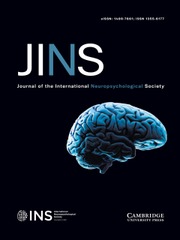Crossref Citations
This article has been cited by the following publications. This list is generated based on data provided by
Crossref.
Merritt, Victoria C.
Ukueberuwa, Dede M.
and
Arnett, Peter A.
2016.
Relationship between the apolipoprotein E gene and headache following sports-related concussion.
Journal of Clinical and Experimental Neuropsychology,
Vol. 38,
Issue. 9,
p.
941.
McCrea, Michael
Meier, Timothy
Huber, Daniel
Ptito, Alain
Bigler, Erin
Debert, Chantel T
Manley, Geoff
Menon, David
Chen, Jen-Kai
Wall, Rachel
Schneider, Kathryn J
and
McAllister, Thomas
2017.
Role of advanced neuroimaging, fluid biomarkers and genetic testing in the assessment of sport-related concussion: a systematic review.
British Journal of Sports Medicine,
Vol. 51,
Issue. 12,
p.
919.
Iverson, Grant L
Gardner, Andrew J
Terry, Douglas P
Ponsford, Jennie L
Sills, Allen K
Broshek, Donna K
and
Solomon, Gary S
2017.
Predictors of clinical recovery from concussion: a systematic review.
British Journal of Sports Medicine,
Vol. 51,
Issue. 12,
p.
941.
Arnett, Peter
Meyer, Jessica E.
Merritt, Victoria C.
Gatzke‐Kopp, Lisa
and
Shannon Bowen, Katherine E.
2017.
Child and Adolescent Psychopathology, Third Edition.
p.
316.
Yue, John K.
Robinson, Caitlin K.
Burke, John F.
Winkler, Ethan A.
Deng, Hansen
Cnossen, Maryse C.
Lingsma, Hester F.
Ferguson, Adam R.
McAllister, Thomas W.
Rosand, Jonathan
Burchard, Esteban G.
Sorani, Marco D.
Sharma, Sourabh
Nielson, Jessica L.
Satris, Gabriela G.
Talbott, Jason F.
Tarapore, Phiroz E.
Korley, Frederick K.
Wang, Kevin K.W.
Yuh, Esther L.
Mukherjee, Pratik
Diaz‐Arrastia, Ramon
Valadka, Alex B.
Okonkwo, David O.
and
Manley, Geoffrey T.
2017.
Apolipoprotein E epsilon 4 (APOE‐ε4) genotype is associated with decreased 6‐month verbal memory performance after mild traumatic brain injury.
Brain and Behavior,
Vol. 7,
Issue. 9,
Panenka, William J.
Gardner, Andrew J.
Dretsch, Michael N.
Crynen, Gogce C.
Crawford, Fiona C.
and
Iverson, Grant L.
2017.
Systematic Review of Genetic Risk Factors for Sustaining a Mild Traumatic Brain Injury.
Journal of Neurotrauma,
Vol. 34,
Issue. 13,
p.
2093.
Polimanti, Renato
Chen, Chia-Yen
Ursano, Robert J.
Heeringa, Steven G.
Jain, Sonia
Kessler, Ronald C.
Nock, Matthew K.
Smoller, Jordan W.
Sun, Xiaoying
Gelernter, Joel
and
Stein, Murray B.
2017.
Cross-Phenotype Polygenic Risk Score Analysis of Persistent Post-Concussive Symptoms in U.S. Army Soldiers with Deployment-Acquired Traumatic Brain Injury.
Journal of Neurotrauma,
Vol. 34,
Issue. 4,
p.
781.
Mc Fie, Sarah
Abrahams, Shameemah
Patricios, Jon
Suter, Jason
Posthumus, Michael
and
September, Alison V.
2018.
Inflammatory and apoptotic signalling pathways and concussion severity: a genetic association study.
Journal of Sports Sciences,
Vol. 36,
Issue. 19,
p.
2226.
Bigler, Erin D.
2018.
Structural neuroimaging in sport-related concussion.
International Journal of Psychophysiology,
Vol. 132,
Issue. ,
p.
105.
Cochrane, Graham D.
Sundman, Mark H.
Hall, Eric E.
Kostek, Matthew C.
Patel, Kirtida
Barnes, Kenneth P.
and
Ketcham, Caroline J.
2018.
Genetics Influence Neurocognitive Performance at Baseline but Not Concussion History in Collegiate Student-Athletes.
Clinical Journal of Sport Medicine,
Vol. 28,
Issue. 2,
p.
125.
Legarreta, Andrew D.
Brett, Benjamin L.
Solomon, Gary S.
and
Zuckerman, Scott L.
2018.
The role of family and personal psychiatric history in postconcussion syndrome following sport-related concussion: a story of compounding risk.
Journal of Neurosurgery: Pediatrics,
Vol. 22,
Issue. 3,
p.
238.
Esopenko, Carrie
Simonds, Adrienne H
and
Anderson, Ellen Z
2018.
The synergistic effect of concussions and aging in women? Disparities and perspectives on moving forward.
Concussion,
Vol. 3,
Issue. 2,
p.
CNC55.
Khoury, Samar
and
Benavides, Rodrigo
2018.
Pain with traumatic brain injury and psychological disorders.
Progress in Neuro-Psychopharmacology and Biological Psychiatry,
Vol. 87,
Issue. ,
p.
224.
Deng, Hansen
Ordaz, Angel
Upadhyayula, Pavan S.
Gillis-Buck, Eva M.
Suen, Catherine G.
Melhado, Caroline G.
Mohammed, Nebil
Lam, Troy
and
Yue, John K.
2018.
Apolipoprotein E Epsilon 4 Genotype, Mild Traumatic Brain Injury, and the Development of Chronic Traumatic Encephalopathy.
Medical Sciences,
Vol. 6,
Issue. 3,
p.
78.
Terrell, Thomas Roland
Abramson, Ruth
Barth, Jeffery T
Bennett, Ellen
Cantu, Robert C
Sloane, Richard
Laskowitz, Daniel T
Erlanger, David M
McKeag, Douglas
Nichols, Gregory
Valentine, Verle
and
Galloway, Leslie
2018.
Genetic polymorphisms associated with the risk of concussion in 1056 college athletes: a multicentre prospective cohort study.
British Journal of Sports Medicine,
Vol. 52,
Issue. 3,
p.
192.
Tensaouti, Yacine
Stephanz, Elizabeth P.
Yu, Tzong-Shiue
and
Kernie, Steven G.
2018.
ApoE Regulates the Development of Adult Newborn Hippocampal Neurons.
eneuro,
Vol. 5,
Issue. 4,
p.
ENEURO.0155-18.2018.
Rice, Simon M.
Parker, Alexandra G.
Rosenbaum, Simon
Bailey, Alan
Mawren, Daveena
and
Purcell, Rosemary
2018.
Sport-Related Concussion and Mental Health Outcomes in Elite Athletes: A Systematic Review.
Sports Medicine,
Vol. 48,
Issue. 2,
p.
447.
Costello, Daniel M
Kaye, Andrew H
O'Brien, Terence J
and
Shultz, Sandy R
2018.
Sport related concussion – Potential for biomarkers to improve acute management.
Journal of Clinical Neuroscience,
Vol. 56,
Issue. ,
p.
1.
Walter, Alexa
Herrold, Amy A.
Gallagher, Virginia T.
Lee, Rosa
Scaramuzzo, Madeleine
Bream, Tim
Seidenberg, Peter H.
Vandenbergh, David
O'Connor, Kailyn
Talavage, Thomas M.
Nauman, Eric A.
Slobounov, Semyon M.
and
Breiter, Hans C.
2019.
KIAA0319 Genotype Predicts the Number of Past Concussions in a Division I Football Team: A Pilot Study.
Journal of Neurotrauma,
Vol. 36,
Issue. 7,
p.
1115.
Signoretti, Stefano
Tavazzi, Barbara
Lazzarino, Giuseppe
and
Vagnozzi, Roberto
2019.
Concussion and Traumatic Encephalopathy.
p.
138.


